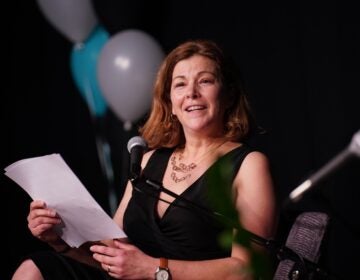Philadelphia Science Festival Continues
ListenApril 22, 2013
Image credit: NASA Ames/JPL-Caltech
[Dave Heller]: Get out the shampoo and the loofah sponge and prepare for a shower. Joining me with details is Derrick Pitts, chief astronomer at the Franklin Institute.
[Derrick Pitts]: I’m afraid you’ll have to bring your own water though. It’s the Lyrid meteor shower we’re talking about – with a radiant point in the constellation Lyra which is a beautiful summer constellation. Since we’re not quite at mid-summer yet, that means it’s rising late in the evening.
The trick about the Lyrid shower is that even though its meteors can be very, very swift and quite bright, there just aren’t many of them. We’re looking at something around the neighborhood of 18 – 20 per hour. It doesn’t rank among the big ones. The big ones are the Perseid meteor shower in August, with somewhere between 60 – 100 per hour; and then the Geminid shower in December with rates up to 120 per hour. Those are real significant ones.
But, it’s a good one for Spring time I suppose especially if you have good, dark skies.
Then let’s hold out for a little later in the week for what must be a very vivid lunar eclipse.
Wouldn’t that be something. But, unfortunately, again, it isn’t. The problem here is that the lunar eclipse coming up this week is unfortunately not visible to us on this side of the planet.
I’m sure there is great goings on this week right here in Philadelphia.
Absolutely. The Philadelphia Science Festival has so many events all over the city. Many of them are free, but you do have to register for them. Of course you can do that online at philasciencefestival.org
Not only that, The Franklin Institute’s awards program takes place this week also. We bring in the best, brilliant minds in science to Philadelphia for this awards program in which we honor them for the work they’ve done in a lot of different disciplines. These are the highest selected scientists from around the world.
In addition, coming up on Friday, we have the city-wide astronomy night. It’s one of the signature events of the Science Festival. We’ll have telescopes at 22 different locations around town. In community centers. At colleges and universities. In nature reserves. All kinds of places where you can find a telescope where you can see: first of all, Jupiter in the evening sky just after sunset; and then Saturn a little bit later in the evening.
You can get those locations also at philasciencefestival.org.
Finally, why don’t you leave us with a bedtime story called “Goldilocks and the two new planetary systems.
I like that one. That’s a good one.
You know the Kepler satellite has been busy trying to identify planets orbiting other stars. It’s looking in a range about 3000 light-years away. It’s monitoring 150,000 stars for drops in brightness. It has been able to identify two new planetary systems just recently.
It turns out that there are three planets of those systems that look they are nearly habitable planets. When we say habitable, what we mean is that they are in the “Goldilocks” zone of their particular star. They are not too close to the star for it to be too hot; not too far away from the star to be too cool for the existence of liquid water.
There are other complicating factors. Each of the planets is much bigger than Earth – at least 40% bigger than Earth. And all of them orbit way too close to their star. So their orbits only take a few days. But, what it does increase the number of planets that we now know to be in the habitable zone up to nine.
Out of the 2,600 that Kepler has identified as candidates, 861 are confirmed exo-planets, and of those 861 there are nine that look like they are in that star’s habitable zone.
So, the creep towards finding “Earth-like” is progressing. We haven’t found anything exactly like our planet yet, but as our tools get better and better we hope to get closer and closer to finding something that is pretty much like us.
WHYY is your source for fact-based, in-depth journalism and information. As a nonprofit organization, we rely on financial support from readers like you. Please give today.




